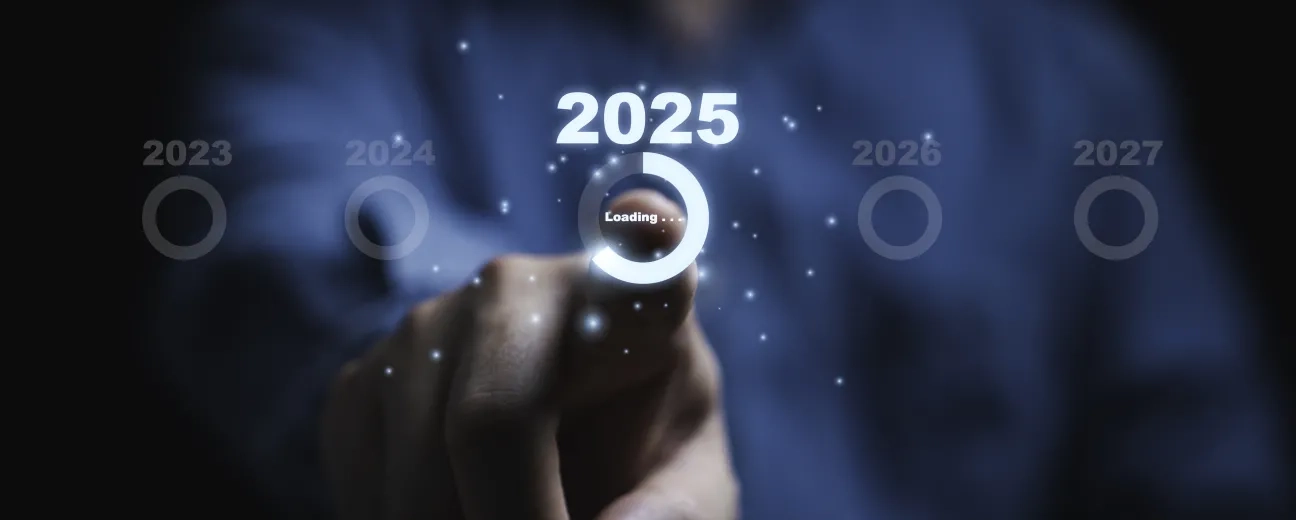
We’re excited to hear your project.
Let’s collaborate!

No one can predict the future of web development. But staying ahead of emerging trends makes it easier to navigate this evolving industry.
Technology moves fast. Developers and businesses must adapt constantly—new tools, innovative methodologies, and shifting user expectations reshape the landscape.
Instead of guessing what’s next, focus on what’s shaping the industry today. Understanding these advancements puts businesses in a position to build better websites and applications that meet modern demands.
This guide highlights the most important trends for 2025. No magic formula, just insights and actionable strategies to help you stay competitive.
AI is changing everything, and web development is no exception. Repetitive coding tasks? Automated. That leaves developers free to focus on complex, creative work.
Tools like Gemini, Copilot, and ChatGPT are already making waves. AI writes better code, debugs faster, and even generates entire web applications with minimal effort.
The numbers tell the story:
Beyond coding, AI transforms UX/UI design. It analyzes user behavior, provides personalized recommendations, and optimizes performance in real time. Businesses that integrate AI-driven development gain an edge—more intelligent, user-friendly websites that adapt to user needs.
Smart devices are everywhere. From Alexa to wearable health trackers, the Internet of Things (IoT) is changing how people interact with technology.
Web development must keep up. IoT-driven applications process real-time data, offering users seamless, data-driven experiences.
A few key stats:
Building secure, scalable IoT applications is now a priority. Developers must ensure smooth communication between devices while handling vast amounts of real-time data.
Web development isn’t just for developers anymore. Low-code and no-code platforms let businesses build applications with minimal technical expertise.
Drag-and-drop interfaces make it possible to create functional applications fast. The benefits are clear:
Platforms like Bubble, Adalo, and OutSystems make it easy to build apps for e-commerce, customer support, and automation. Startups and small businesses, in particular, stand to benefit from these cost-effective tools.
However, while these platforms simplify development, ongoing website maintenance remains crucial to ensure security, performance, and scalability.
Data alone isn’t enough. The Internet of Behavior (IoB) takes it further, merging behavioral psychology with analytics to create personalized web experiences.
Instead of just connecting devices like IoT, IoB studies user behavior—tracking habits, preferences, and interactions to tailor digital experiences.
The impact is huge:
IoB makes e-commerce smarter and web interactions more engaging. Businesses that leverage this technology create experiences that convert.
Fast, seamless browsing is no longer optional. Single Page Applications (SPAs) load content dynamically without refreshing the entire page. The result? An app-like experience that keeps users engaged.
The trend is growing:
Tech giants like Google, Facebook, and Twitter rely on SPAs. Developers using frameworks like React, Angular, and Vue.js can create dynamic, responsive web applications that keep users coming back.
Managing servers is a thing of the past. Serverless computing lets developers focus entirely on application logic. Backend servers? No longer a concern.
Platforms like AWS Lambda and Google Cloud Functions run code only when needed, cutting costs and scaling automatically. Adoption is rising fast:
With pay-as-you-go pricing, serverless architecture offers cost-effective, high-performance solutions for modern web development.
Containers are changing how applications are built and deployed. They make software more portable, scalable, and efficient. Tools like Docker and Kubernetes ensure that applications run consistently across different environments.
The advantages are clear:
As agile development and continuous integration become standard, container technology is a must-have for modern software engineering.
Keeping up with web trends isn’t easy. OPTASY makes it simpler.
✅ AI-Powered Web Development – Automating coding for faster project delivery.
✅ IoT & Edge Computing – Building data-driven applications.
✅ Low-Code & No-Code – Rapid application development.
✅ SPAs & Serverless Architecture – Scalable, high-performance web solutions.
✅ Containers & Cloud Computing – Secure, flexible digital services.
Staying ahead in web development isn’t just about adopting the latest trends. It’s about knowing how to apply them strategically. OPTASY doesn’t just follow trends—it helps businesses leverage them for growth.
With a track record of building scalable web solutions, OPTASY provides:
✅ Custom-built strategies – Tailored solutions based on business needs.
✅ Expert development teams – A deep understanding of cutting-edge technologies.
✅ End-to-end digital transformation – From concept to execution, OPTASY handles it all.
The future of web development is here. AI, IoT, no-code tools, behavioral analytics, SPAs, serverless computing, and containerization are shaping 2025.
Businesses that adapt to these trends will gain a competitive edge. Those that don’t risk falling behind.
Web development moves fast. The question is, are you ready to move with it?
Contact OPTASY today to get started.

We’re excited to hear your project.
Let’s collaborate!